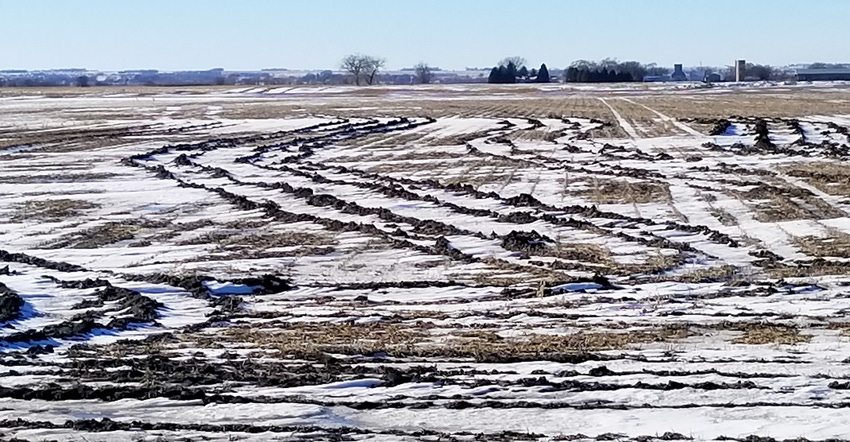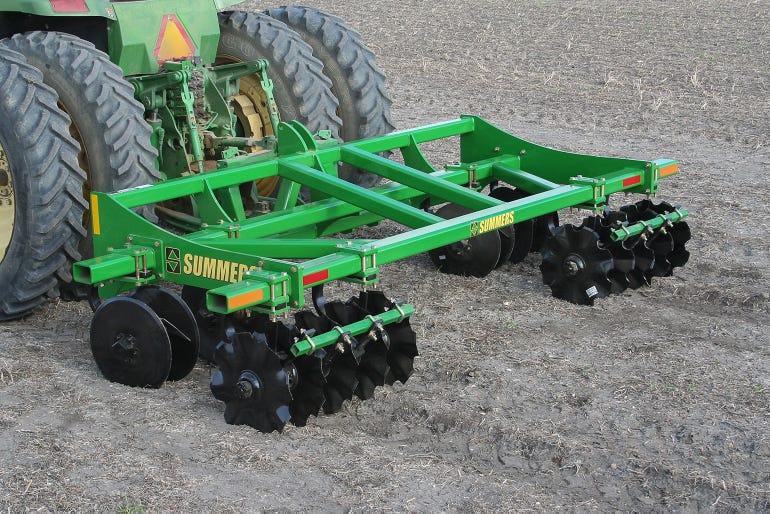March 26, 2020

Repairing ruts has become a new rite of spring in the Dakotas. A new tool for fixing ruts and the latest tips and advice from industry and Extension soil and tillage experts include:
New implement
Summers Mfg. has a new 3-point implement to repair ruts called the 3RT 2010. It consists of four gangs of adjustable blades and coulters that can be positioned over the tracks left by combines, tractors, grain carts or sprayers. Twenty-two-inch dual-mounted, adjustable-angle disk blades bring dirt into the rut, while 22-inch five-blade coulter gangs act as levelers to leave an optimal field finish.
The 3-point mounted 3RT 2010 can be configured from 90- to 132-inch-wide center-to-center spacing so only the intended parts of the field are worked.
“The idea for the 3RT 2010 came from our customers,” according to Bruce Johnson, director of innovation for Summers Mfg.
 RUT FIXER: A new implement from Summers Mfg. can be adjusted to so that the disk blades and coulters run over wheel tracks.
RUT FIXER: A new implement from Summers Mfg. can be adjusted to so that the disk blades and coulters run over wheel tracks.

Go online to learn more about the 3RT 2010.
Tried and true
The key to repairing ruts efficiently is to do shallow tillage and only till the ruts themselves, not the whole fields, according to Anthony Bly, South Dakota State University Extension soil health specialist.
A light tillage pass when the soil is dry with a vertical tillage tool, light disk, soil finisher or harrow (in shallow rut cases) will fill in ruts and prevent further soil compaction,
With very deep ruts, multiple tillage passes may be needed. Each pass will need to be a little deeper than the previous one to disrupt the sides and bottom of the track. Ideally, allow time (at least two weeks) in-between passes for the soil to dry.
Repairing ruts will work best after the top 2 to 4 inches of topsoil is dry. Make sure subsoils are dry enough tillage if further passes are needed. Otherwise, tillage could make issues worse with smeared, compacted soil surfaces.
“It’s often assumed deep tillage is the best fix for rut compaction, but it isn’t,” Bly says. “Deep tillage will smear and compact the soil at lower depths with excessive moisture and may cause even more compaction damage.”
4 tips for rut management
Jodi DeJong Hughes, University of Minnesota Extension soil specialist, shares the four top tips to know about managing ruts:
If the soil is wet, stay off the field as long as you can.
If you need to dry out the soil and manage residue, use a vertical till pass versus a field cultivator. A field cultivator will smear a plow layer in a wet soil.
Check axle loads. Stay as light as possible. Use smaller tractors and make fewer seedbed prep passes.
Check tire pressure. Add duals or triples. The advantage of duals and triples is that you can decrease the tire pressure for the same load and that expands the tire footprint. Properly inflated radial tires will result in no more compaction than tracks.
Prevention
To reduce the risk of rutting up fields in the future, Sarah Bauder, SDSU Extension agronomist, suggests no-tilling and planting cover crops.
Tillage destroys soil structure and makes the soil softer. Soils that have been no-tilled and have a cover crop growing on them can carry more weight before ruts begin to form. Eventually the infiltration rate of no-till soil with cover crops will increase and reduce runoff and ponding.
You May Also Like




